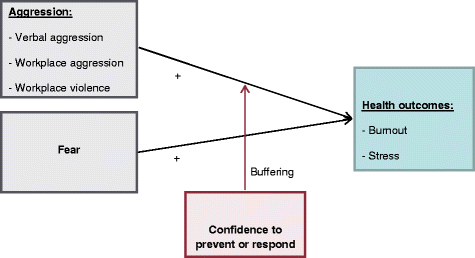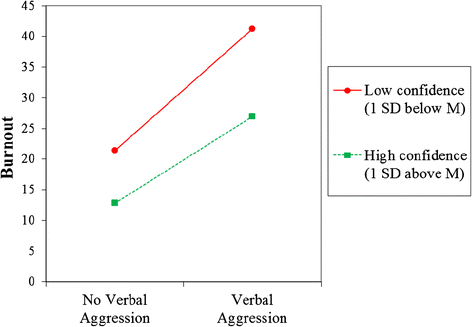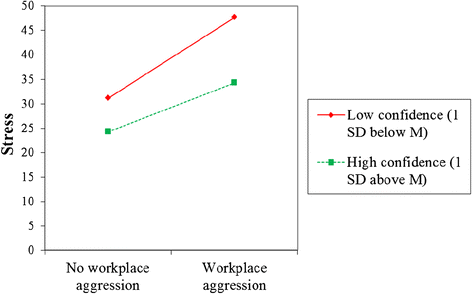Workplace violence against homecare workers and its relationship with workers health outcomes: a cross-sectional study
- PMID: 25595487
- PMCID: PMC4308913
- DOI: 10.1186/s12889-014-1340-7
Workplace violence against homecare workers and its relationship with workers health outcomes: a cross-sectional study
Abstract
Background: Consumer-driven homecare models support aging and disabled individuals to live independently through the services of homecare workers. Although these models have benefits, including autonomy and control over services, little evidence exists about challenges homecare workers may face when providing services, including workplace violence and the negative outcomes associated with workplace violence. This study investigates the prevalence of workplace violence among homecare workers and examines the relationship between these experiences and homecare worker stress, burnout, depression, and sleep.
Methods: We recruited female homecare workers in Oregon, the first US state to implement a consumer driven homecare model, to complete an on-line or telephone survey with peer interviewers. The survey asked about demographics and included measures to assess workplace violence, fear, stress, burnout, depression and sleep problems.
Results: Homecare workers (n = 1,214) reported past-year incidents of verbal aggression (50.3% of respondents), workplace aggression (26.9%), workplace violence (23.6%), sexual harassment (25.7%), and sexual aggression (12.8%). Exposure was associated with greater stress (p < .001), depression (p < .001), sleep problems (p < .001), and burnout (p < .001). Confidence in addressing workplace aggression buffered homecare workers against negative work and health outcomes.
Conclusions: To ensure homecare worker safety and positive health outcomes in the provision of services, it is critical to develop and implement preventive safety training programs with policies and procedures that support homecare workers who experience harassment and violence.
Figures



Similar articles
-
Computer-based training (CBT) intervention reduces workplace violence and harassment for homecare workers.Am J Ind Med. 2017 Jul;60(7):635-643. doi: 10.1002/ajim.22728. Am J Ind Med. 2017. PMID: 28616887 Clinical Trial.
-
Exploring workplace violence among home care workers in a consumer-driven home health care program.Workplace Health Saf. 2013 Oct;61(10):441-50. doi: 10.1177/216507991306101004. Epub 2013 Sep 23. Workplace Health Saf. 2013. PMID: 24053217
-
Shifting the Safety Culture: Evaluation of a Novel Approach to Understanding and Responding to Workplace Harassment and Violence Experienced by Homecare Workers.Workplace Health Saf. 2024 Jul;72(7):274-282. doi: 10.1177/21650799241232148. Epub 2024 Mar 7. Workplace Health Saf. 2024. PMID: 38454778 Free PMC article.
-
Violence in the workplace. The occurrence of the phenomenon in relation to health care workers.Psychiatr Pol. 2024 Apr 30;58(2):351-362. doi: 10.12740/PP/OnlineFirst/152775. Epub 2024 Apr 30. Psychiatr Pol. 2024. PMID: 36648236 Review. English, Polish.
-
Prevalence and policy of occupational violence against oral healthcare workers: systematic review and meta-analysis.BMC Oral Health. 2019 Dec 12;19(1):279. doi: 10.1186/s12903-019-0974-3. BMC Oral Health. 2019. PMID: 31830978 Free PMC article.
Cited by
-
The association between workplace violence and physicians' and nurses' job satisfaction in Macau.PLoS One. 2018 Dec 5;13(12):e0207577. doi: 10.1371/journal.pone.0207577. eCollection 2018. PLoS One. 2018. PMID: 30517126 Free PMC article.
-
The impact of workplace violence on job burnout among Chinese correctional officers: the chain mediating effects of stress and insomnia.BMC Public Health. 2024 Feb 22;24(1):566. doi: 10.1186/s12889-024-18048-1. BMC Public Health. 2024. PMID: 38388879 Free PMC article.
-
Workplace Violence Is Home Now for Healthcare Workers: Spillover Theory Perspective.Stress Health. 2025 Feb;41(1):e70008. doi: 10.1002/smi.70008. Stress Health. 2025. PMID: 39874062 Free PMC article.
-
Workplace Violence Experienced by Personal Care Workers in a District in Seoul, Republic of Korea: A Comparison Study with Office and Service Workers.Healthcare (Basel). 2024 Jan 26;12(3):320. doi: 10.3390/healthcare12030320. Healthcare (Basel). 2024. PMID: 38338205 Free PMC article.
-
Sexual Harassment by Patients, Clients, and Residents: Investigating Its Prevalence, Frequency and Associations with Impaired Well-Being among Social and Healthcare Workers in Germany.Int J Environ Res Public Health. 2021 May 13;18(10):5198. doi: 10.3390/ijerph18105198. Int J Environ Res Public Health. 2021. PMID: 34068346 Free PMC article.
References
-
- United Nations Population Fund (UNFPA). United Nations Population Fund (UNFPA). Aging in the 21st century: a celebration and a challenge: Executive summary, 2012. New York and London; 2012.
-
- Bettio F, Verashchagina A. Long-Term Care for the elderly: Provisions and providers in 33 European countries. 2012. [http://ec.europa.eu/justice/gender-equality/files/elderly_care_en.pdf]
-
- Francis J. UKHCA Summary paper: An overview of the UK domiciliary care sector. No. 3083104 [http://www.ukhca.co.uk/pdfs/domiciliarycaresectoroverview.pdf]
-
- Nakaishi L, Moss H, Weinstein M, Perrin N, Rose L, Anger WK, Hanson GC, Christian M, Glass N. Exploring workplace violence among home care workers in a consumer-driven home health care program. Workplace Health Saf. 2013;61:441–50. - PubMed
Publication types
MeSH terms
Grants and funding
LinkOut - more resources
Full Text Sources
Other Literature Sources
Medical
Miscellaneous

